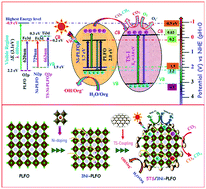Enhanced visible-light photoactivities of porous LaFeO3 by synchronously doping Ni2+ and coupling TS-1 for CO2 reduction and 2,4,6-trinitrophenol degradation†
Abstract
Herein, Ni2+ species-doped and TS-1-coupled porous LaFeO3 nanocomposites have been successfully fabricated via carbon nanospheres (CNS) in a sequential template approach (STA). XPS, inductively coupled plasma emission spectroscopy (ICP-AES), TEM, DRS, fluorescence spectra related to ˙OH amount, photoelectrochemical I–V curves, TPD and BET results have confirmed that the introduction of pores increased the surface area, and the incorporation of Ni2+ species extended the light absorption capability by creating surface states and optimizing the band gap positions. The coupling of TS-1 performed the dual function of expanding the surface area and enhancing the charge separation by upgrading high-level energy electrons. Compared to the pristine porous LaFeO3, the optimized 3Ni-PLFO and 5TS/3Ni-PLFO nanocomposites have suitable band gap positions and efficient visible-light photocatalytic activities for CO2 reduction and 2,4,6-trinitrophenol degradation. Interestingly, compared to PLFO, the resulting 5TS/3Ni-PLFO nanocomposite showed 2.5-times improvement for CO2 reduction and 3-times improvement for 2,4,6-trinitrophenol (TNP) degradation. It was confirmed from radical trapping experiments that the photogenerated holes and ˙OH are the potent oxidants in the photocatalytic degradation of 2,4,6-trinitrophenol degradation. The single wavelength photocurrent action spectrum confirmed that the simultaneous doping of Ni2+ species and coupling of TS-1 optimized the band gap and upgraded HLEEs of LaFeO3, respectively. This novel research approach opens a new gateway for synthesizing large surface area and visible-light-active efficient LaFeO3-based photocatalysts for CO2 conversion and environmental remediation.



 Please wait while we load your content...
Please wait while we load your content...